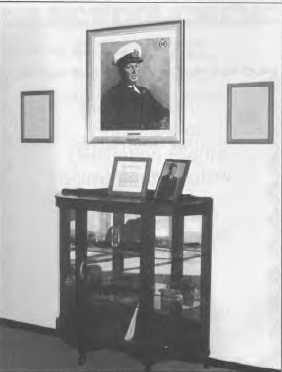- Author
- Worledge, Ray
- Subjects
- History - general, Biographies and personal histories
- Tags
-
- RAN Ships
- HMAS Rushcutter (Shores establishment), HMAS Watson (base)
- Publication
- December 1998 edition of the Naval Historical Review (all rights reserved)
On October 28, 1997 the Royal Australian Navy’s Surface Warfare School Building was formally renamed the “Newcomb Building”, commemorating the service of Captain Harvey Mansfield Newcomb.
At the end of 1938 LCDR Newcomb RN was serving as First Lieutenant and Senior Instructional Officer at HMS Osprey, the Royal Navy’s anti-submarine training establishment. War with Germany was becoming increasingly likely, and with the threats presented by U-boats in the Great War still fresh in their memories, the Admiralty decided to establish an anti-submarine training school in Sydney. Newcomb was selected for the task, given the rank of Acting Commander, and sent to Sydney at the end of that year. He was accompanied by 9 A/S trained ratings.
The story of HMAS Rushcutter has been told in the book “Contact!“, produced by the Anti-Submarine Officers’ Association, and need not be repeated here. Suffice it to say that by the outbreak of war 66 officers and 32 ratings had completed anti-submarine training.
A flow of officers and ratings to the Royal Navy began almost immediately, so that when the German invasion of France saw fighting begin in earnest Rushcutter trainees were already serving in the North Atlantic. For example, in the ill-fated Norwegian campaign there was an Australian A/S officer in each of the eight large trawlers comprising the 15th and 16th A/S Striking Forces.
In the crucial Battle of the Atlantic Rushcutter men comprised some 20% of the Allied A/S personnel, the best record going to Stanley Darling, who was credited with sinking 3 U-boats and finished as Captain RANR OBE DSC and 2 Bars. Rushcutter graduates were regarded by the Admiralty as being of top calibre.
By the end of the War 326 officers and 1286 ratings had been trained in A/S in Rushcutter, while a large number of officers had completed short courses, including a league of nations of foreign officers.

Newcomb himself was denied the chance of exercising his skills in action, but there is no doubt that by putting his stamp on the A/S School he made a remarkable contribution to the final victory. The local manufacture of A/S equipment would warrant a story in itself. His responsibilities grew until they embraced the Gunnery Instructional Centre, the Radar School, the Motor Launch School, the Mining Service, the Naval Auxiliary Patrol, Randwick Hospital Naval Wing, Canonbury Hospital, DEMS Staff and tenders.
Late in 1945, by then an Acting Captain, he was invited by the Naval Board to stay in Australia and organise the new Electrical Branch of the RAN. He accepted the challenge and produced a most efficient and successful branch, the members being much sought after by civilian firms. His promotion to Captain RN (Rtd) paralleled this employment as Captain RAN.
As his children had grown up in Australia he decided to stay here, and “swallowed the anchor” on 27 September 1956, after eighteen years of outstanding service to the RAN and to Australia. He died in Adelaide on 16 January 1991.
Captain Newcomb never received a decoration. The inevitable question is, “Why?”. His contribution to the war effort was immense. Those who knew him well dismiss any thought that he could have offended a single one of his seniors. The explanation appears to lie in the fact that for some time after the War the RAN saw him as an RN officer, while the Admiralty regarded him as the responsibility of the RAN. The fact remains that he was overlooked. “Newcs”, as one and all called him, just got on with his job.
The failure to accord Captain Newcomb his just recognition greatly concerned his “old boys”, some of whom received decorations for using skills learnt at the School he ran. It can now be revealed that over several years efforts to rectify the omission were made by various of the “old boys”, one of whom was a Cabinet Minister. There was no success, perhaps due to the passage of years. The award of a Chief of Naval Staff Commendation in 1989 was appreciated, but was only a minute tribute to his services.
The posthumous dedication of the Newcomb Building gave great satisfaction to Captain Harvey Newcomb’s many admirers. Captain Martyn Bell CSC ADC, RAN gave the address of dedication, asking Chaplain John Connolly MSC RAN to perform the blessing. The Chaplain said, inter alia, “May the name Newcomb be an inspiration to all who serve their country with diligence and honour“. The ceremony was attended by members of the ASDIC Association and the Anti-Submarine Officers’ Association, while Watson turned on an excellent lunch in the Senior Sailors’ Mess. Mr. Simon Newcomb unveiled a plaque provided by the two Associations, which paid tribute to his father’s memory and included the message: “To you who follow we pass the Torch”.
NEWCOMB BUILDING
This plaque commemorates the naming of the Newcomb Building
on
28 October 1997
in honour and everlasting memory of
Captain Harvey Mansfield Newcomb Royal Navy
“TO YOU WHO FOLLOW WE PASS THE TORCH”
Presented by the ASDIC Association and the Anti-Submarine
Officers Association
Unveiled by his son Simon Newcomb




